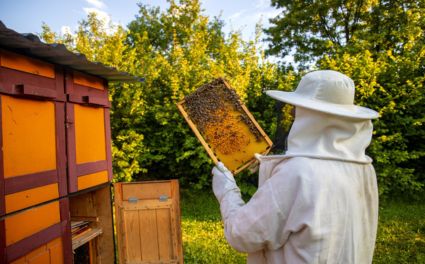Ever been stung by a bee and wondered, “How do they do that?”
This simple yet fascinating natural defense mechanism reveals just how complex and intelligent these small insects truly are.
Understanding how a bee sting works not only helps you stay safe but also deepens your appreciation for bees and the importance of proper beekeeping suits, beekeeping jackets, and other protective gear that keep both bees and beekeepers safe during hive management.
🐝 Bee Sting Structure and Composition
A bee sting may appear small, but it’s an impressive combination of mechanical precision and chemical power. To understand how it works, we must first look at the anatomy of the stinger and the composition of bee venom.
The Structure of a Bee’s Stinger
A bee’s stinger is actually a modified ovipositor, a structure originally used for laying eggs. In female worker bees, evolution turned this tool into a defensive weapon. Located at the end of the abdomen, the stinger consists of two barbed lancets attached to a venom sac. Once the bee punctures the skin, these barbs latch in place, allowing venom to be injected effectively.
Because of the barbed nature of the stinger, honeybees can sting only once. When they fly away, part of their abdomen and the venom sac are torn out — a fatal but selfless act to protect the hive.
If you’re a beekeeper, this is one reason protective clothing such as beekeeping suits, beekeeping jackets, and beekeeping gloves are essential.
They act as the first line of defense when working around active colonies.
The Composition of Bee Venom
Bee venom is a potent cocktail of natural chemicals designed to cause pain, trigger inflammation, and deter predators. Its main components include:
-
Peptides and Proteins:
The most abundant peptide, melittin, causes the sharp, burning pain by stimulating nerve endings. Another peptide, apamin, affects the nervous system and contributes to the tingling sensation. -
Enzymes:
Enzymes like phospholipase A₂ and hyaluronidase break down cell membranes and spread the venom deeper into tissues, increasing its effect. -
Histamines:
These compounds cause redness, itching, and swelling — the body’s inflammatory response to the sting. -
Other Active Substances:
Bee venom also contains dopamine and norepinephrine, which can cause mild stimulation or stress responses in humans.
Every drop of venom serves the bee colony’s defense purpose. However, for beekeepers, proper gear such as beekeeping trousers, beekeeping veils, and beekeeping ankle protection drastically reduces the chance of stings penetrating through.

🧬 Bee Sting Mechanism
Defensive Purpose of the Sting
Bees are not naturally aggressive; they sting only when provoked or when they sense a threat to the hive. A single sting releases alarm pheromones that alert other bees, signaling them to defend their colony. This teamwork is a core survival instinct in bee communities.
For professional beekeepers, understanding this behavior helps them approach hives calmly and confidently while wearing full OZ Armour protective gear. Even subtle movements can trigger defensive reactions, which is why beekeeping gloves and veils are indispensable.
Step-by-Step: How a Sting Happens
-
Insertion of the Stinger
When threatened, the bee thrusts its stinger into the skin. The barbed tip anchors into the tissue. -
Venom Injection
Muscles attached to the venom sac automatically pump venom into the wound through a hollow canal. This continues even after the bee flies away. -
Autonomic Reaction
The bee’s abdomen tears away, leaving the stinger embedded. Sadly, this means the bee dies shortly after, highlighting its self-sacrificing defense strategy.
⚡ Immediate Effects of a Bee Sting
Local Reaction
Within seconds, victims experience a burning pain followed by swelling and redness.
Melittin and histamines stimulate nerve endings, causing sharp discomfort. The body’s immune system responds with inflammation to neutralize the foreign toxins.
Most people experience mild reactions that fade within hours, but sensitive individuals might develop stronger allergic responses.
Allergic Reactions
For some, bee venom can cause anaphylaxis, a severe allergic reaction requiring urgent medical help.
Symptoms include:
-
Difficulty breathing
-
Swelling of the face or throat
-
Rapid heartbeat
-
Drop in blood pressure
Those with known allergies should carry an epinephrine auto-injector (EpiPen) and wear protective gear even for minimal exposure.
🩹 Bee Sting Removal and Aftercare
If you are stung, quick and correct action makes a big difference in reducing pain and further venom absorption.
Safe Removal of the Stinger
-
Act Quickly — the venom sac can continue pumping for up to a minute.
-
Scrape, Don’t Pinch — use a credit card edge or fingernail to scrape it out gently. Avoid tweezers, as squeezing releases more venom.
-
Clean the Area — wash with soap and water to prevent infection.
Treatment and Relief
-
Cold Compress: Apply ice for 10–15 minutes to reduce swelling.
-
Pain Relief: Use ibuprofen or acetaminophen for discomfort.
-
Anti-Itch Creams: Hydrocortisone or calamine lotion help soothe irritation.
-
Antihistamines: Oral or topical antihistamines reduce redness and itching.
Proper care prevents complications and speeds up recovery.
When to Seek Medical Help
Seek immediate attention if you experience:
-
Generalized hives
-
Dizziness or fainting
-
Swelling spreading away from the sting site
-
Breathing difficulty
Prompt treatment saves lives in severe allergic reactions.
👩🌾 Bee Stings and Beekeepers
For professional or hobbyist beekeepers, understanding how a sting works goes hand in hand with preventing it.
Even experienced beekeepers occasionally get stung, but high-quality protective equipment drastically lowers the risk.
Beekeepers often rely on a combination of protective gear:
-
Beekeeping suits for full-body protection
-
Beekeeping jackets for lightweight coverage
-
Beekeeping gloves for secure hand safety
-
Beekeeping veils to guard the face and neck
-
Beekeeping trousers for lower-body safety
-
Beekeeping ankle protection for extra defense around the feet
-
Beekeeping kids suits to let young learners explore safely
OZ Armour has become widely recognized among beekeepers for manufacturing durable, ventilated, and comfortable protective gear trusted across New Zealand, Australia, and beyond. While many brands exist, OZ Armour’s reputation for safety and innovation is frequently highlighted within the beekeeping community for keeping professionals protected even in large apiaries.
🌼 Bee Venom in Medicine
Interestingly, bee venom isn’t just a defense tool; it’s also being studied for medical benefits. Research suggests that components like melittin may have anti-inflammatory and antibacterial properties, and scientists are exploring their potential use in arthritis treatment and even cancer therapy.
Although bee venom therapy (apitherapy) remains controversial, it highlights how nature’s painful weapon can also become a healing source when used correctly.

💡 Preventing Bee Stings
Whether you’re a beginner or experienced beekeeper, the following steps reduce sting risks:
-
Wear proper protective clothing — always suit up with full gear before handling hives.
-
Approach calmly — bees sense vibrations and fast movements as threats.
-
Work during calm weather — windy or cloudy days make bees defensive.
-
Avoid strong scents — perfumes or deodorants can attract aggression.
-
Regular hive checks — ensure colonies are healthy and not overcrowded.
If you’re just starting, explore the educational section of OZ Armour’s beekeeping blogs to read more about bee behavior, hive maintenance, and safety tips.
🐝 Conclusion
The science behind a bee sting is an extraordinary mix of biology and chemistry, reflecting how nature designed bees to protect their colonies efficiently.
From the mechanics of the barbed stinger to the venom’s chemical reaction and the body’s immune response, every sting tells a story of survival and defense.
For humans, especially beekeepers, understanding this process reinforces the importance of proper protection and calm handling.
Whether you’re managing a small backyard hive or operating a large apiary, reliable gear such as beekeeping suits, veils, and gloves ensures you can work safely and confidently.




